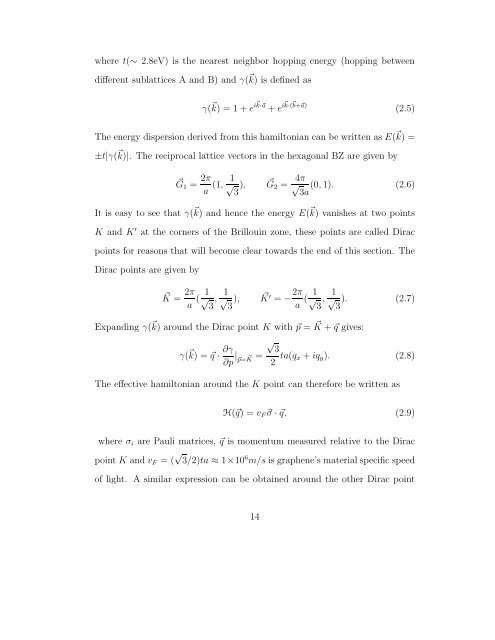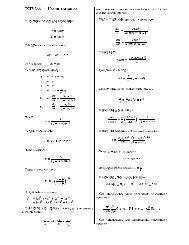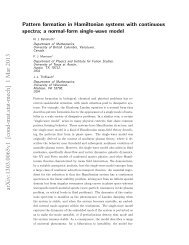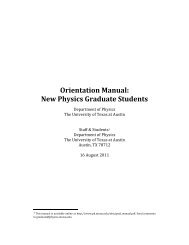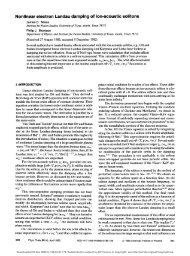- Page 1: CopyrightbyYafis Barlas2008
- Page 4 and 5: Dedicated to Ammi, Abbu and Amma.
- Page 6 and 7: ditional love and support throught
- Page 8 and 9: the Dirac point.In the second half
- Page 10 and 11: Chapter 5. Plasmons and The Spectra
- Page 12 and 13: List of Figures2.1 This figure show
- Page 14 and 15: 4.3 “Lindhard” function χ (0)
- Page 16 and 17: Chapter 1IntroductionThe discovery
- Page 18 and 19: systems where the notion of ”quas
- Page 20 and 21: tinuum model. We find that level re
- Page 22 and 23: dispersion of 2.1 is ǫ J (⃗q)
- Page 24 and 25: chanical exfoliation[9,10] . Graphi
- Page 26 and 27: Fermi velocity much smaller than th
- Page 30 and 31: Figure 2.4: (Adapted from [10]) Lef
- Page 32 and 33: eigenstates of the helicity operato
- Page 34 and 35: Figure 2.6: Lattice structure of bi
- Page 36 and 37: Identifying m α v 2 = |γ 1 cos(
- Page 38 and 39: Figure 2.7: (Adapted from [26]) Thi
- Page 40 and 41: The energy spectrum of a chiral sys
- Page 42 and 43: Figure 2.8: (Adapted from [3] Hall
- Page 44 and 45: Chapter 3Chirality and Correlations
- Page 46 and 47: mation in the screening of Coulomb
- Page 48 and 49: Figure 3.3: Dirac cone for n-doped
- Page 50 and 51: 3.1 RPA Theory of GrapheneWe study
- Page 52 and 53: δεx/εF2.11.751.41.050.7Λ = 10Λ
- Page 54 and 55: 0-0.35δε RPAc /εF-0.7-1.05Λ = 1
- Page 56 and 57: 10.9κ/κ00.80.70.60.50 1 2 3 4 5fF
- Page 58 and 59: orbital response.Our results for th
- Page 60 and 61: The physical origin of the velocity
- Page 62 and 63: states of the interacting system. S
- Page 64 and 65: Coulomb interaction is renormalized
- Page 66 and 67: pole. Σ describes the interaction
- Page 68 and 69: contribution Σ line . In the zero-
- Page 70 and 71: have contributions that are analyti
- Page 72 and 73: used in DFT. The accuracy of graphe
- Page 74 and 75: Figure 4.2: In a weakly doped mater
- Page 76 and 77: Z10.80.60.4(a)Λ = 10 1Λ = 10 2Λ
- Page 78 and 79:
Angle-resolved photoemission spectr
- Page 80 and 81:
most important features in Fig. 4.2
- Page 82 and 83:
F(x, y) → −παgrl(α 2 gr )|x|
- Page 84 and 85:
conduction band states and k and q
- Page 86 and 87:
2D tunneling spectroscopy [69], wil
- Page 88 and 89:
4433ΩεF2ΩεF210.000.07∞ 0.37 0
- Page 90 and 91:
21.510.5ImΣ +ReΣ +A +ω−k+1k=0.
- Page 92 and 93:
Figure 6.1: This figure shows hall
- Page 94 and 95:
Laughlin wrote a variational wavefu
- Page 96 and 97:
Figure 6.2: The direction of the lo
- Page 98 and 99:
these topological excitation carry
- Page 100 and 101:
Figure 6.3: Phase diagram of a doub
- Page 102 and 103:
Chapter 7Octet Quantum Hall Ferroma
- Page 104 and 105:
the two low energy sites [13] (the
- Page 106 and 107:
the lowest energy eigenvectors of H
- Page 108 and 109:
Octet quantum Hall ferromagnets hav
- Page 110 and 111:
|z 1X | 2 = 1. The corresponding im
- Page 112 and 113:
0.6q l B ∞0.50.4Ω0.30.20.1 V ⩵
- Page 114 and 115:
As noted in [13] trigonal warping c
- Page 116 and 117:
ized velocity and quasiparticle spe
- Page 118 and 119:
Appendices103
- Page 120 and 121:
where µ is the Fermi energy of a d
- Page 122 and 123:
from the general formula. I will al
- Page 124 and 125:
and cosθ = z+z−12and using the i
- Page 126 and 127:
Appendix BCorrelation Self-energy o
- Page 128 and 129:
Similar to the electron gas situati
- Page 130 and 131:
[10] A. H. Castro Neto, F. Guinea,
- Page 132 and 133:
[36] D.C. Tsui, H.L. Stormer, and A
- Page 134 and 135:
Sarma, E.H. Hwang and W.K. Tse Phys
- Page 136 and 137:
[73] B.I. Halperin. Phys. Rev. Lett
- Page 138 and 139:
[93] Y. Barlas, Jules Lambert, R. C
- Page 140:
VitaYafis Barlas was born in Karach


